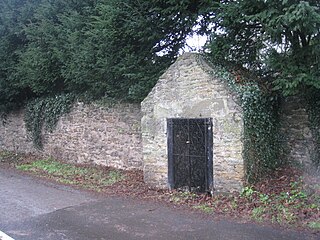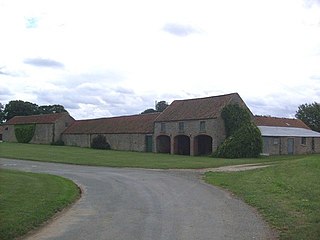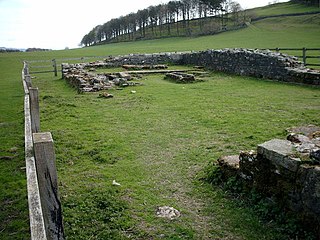
Poling Preceptory was a priory in West Sussex, England. It is a Grade I listed building . [1] .

Poling Preceptory was a priory in West Sussex, England. It is a Grade I listed building . [1] .

Great Wilbraham Preceptory is a preceptory in Great and Little Wilbraham, Cambridgeshire. Much of the Church of Saint Nicholas at Great Wilbraham dates back to 1226 when a preceptory was established here by the Knights Templar when the manor was given to Alan Martel, who was at that time Templar Master. There is a Templar tombstone hidden away under the tower and a Templar cross on the outside north wall. In the nearby village of Little Wilbraham, at Temple End, an Elizabethan manor house stands on the site of the preceptory. Previous to the ownership of the Templars, the lands were held by monks of Ely. At the dissolution of the Templar order, ownership passed into the hands of the Knights of St John of Jerusalem.

Bottesford Preceptory was sited at Bottesford, just to the south of Scunthorpe, in Lindsey, England. It was on low-lying land, near the Bottesford Beck, about 3 miles (5 km) to the west of the escarpment of the Lincoln Cliff limestone upland, and about the same distance to the east of the River Trent. A preceptory was a community of the Knights Templar who lived on one of that order's estates in the charge of its preceptor. A preceptory also referred to the estate and its buildings. The present Bottesford Manor is believed to have been the gatehouse to the preceptory.

Rothley Court is a country house at Rothley in Leicestershire, England. It was mentioned in the Domesday Book and later, as Rothley Temple, associated with the Knights Templar. At the Dissolution it became a private house and the seat of the Babington family; Thomas Babington Macaulay was born there in 1800. It now functions as the Rothley Court Hotel.

Shalford Preceptory was a preceptory of Knights Hospitaller at Shalford in the civil parish of Brimpton in the English county of Berkshire. It was established in the late 12th century. By 1338, it had merged with the preceptory at Greenham.
Shingay Preceptory was a Knights Hospitaller priory at Shingay in Cambridgeshire, England. It was established in 1144. The moated site is a scheduled ancient monument.
Bodmiscombe Preceptory was a priory in Devon, England. It was run by the Knights Hospitaller and was possibly founded during the reign on Henry III and dissolved into Buckland Abbey in the 15th century.
Quenington Preceptory was a preceptory of the Knights Hospitaller in Quenington, Gloucestershire, England. The manor of Quenington was given by Agnes de Lucy and her daughter Sibilla to the order, who established the preceptory in 1193, adding to it the manor of Wishanger, the gift of Asculf Musard. By 1338 the Hospitallers had also acquired the churches of Lower Guiting, Southrop, Down Ampney and Siddington. The preceptory, which in the interim had taken over the possessions of the preceptory of Clanfield in Oxfordshire as well, was surrendered to the Crown in 1540 as part of the possessions of Clerkenwell Priory.
Temple Guiting Preceptory was a medieval monastic house of the Knights Templar in Gloucestershire, England. It was founded around the middle of the twelfth century, receiving grants of land from Gilbert de Lacy and Roger de Waterville. Following the closure of the order in 1308–1309, the last preceptor of Guiting was sent to a monastery in the Diocese of Worcester with a small maintenance charged upon the lands of Temple Guiting.
Great Limber Priory, Limber Magna was a priory in Great Limber, Lincolnshire, England.
Great Limber Preceptory, Limber Magna was a Camera (farm) of the Knights Templar and later the Knights Hospitaller in the village of Great Limber, Lincolnshire, England.
Maltby Preceptory was a house of the Knights Hospitaller in the village of Maltby, Lincolnshire, England. There are two differing accounts regarding its history.

Chibburn Preceptory are the ruins of a Medieval/Post-Medieval Hospitaller preceptory near Widdrington in Northumberland, England. The preceptory was first recorded in 1313, and it was abolished in 1540 when all its lands were passed to the Crown and later the Widdrington family. Low Chibburn had several uses, ranging from a hospital to a dowager house before being razed by French invaders in 1691. The preceptory buildings have undergone repair and restoration by Northumberland County Council, and the site is now a Scheduled Ancient Monument protected by law.

Foulbridge Preceptory was a preceptory of the Knights Templar at Foulbridge near Snainton in North Yorkshire, England of which there is little information. Upon the Dissolution of the Monasteries it possessed the estates of Foukebridge, Allerston, and Wydale. Richard de Hales is the only preceptor known by name due to his arrest in 1308. Foulbridge Farm now stands on the grounds of the former preceptory and has incorporated some remains of the latter.

Penhill Preceptory was a priory on the northern flanks of Penhill in Wensleydale, North Yorkshire, England, which functioned from about 1142 to 1308–12.
Snainton Preceptory was a priory, just south of the village of Snainton, in North Yorkshire, England. The preceptory was started by the Knights Templar at Foulbridge which sits 1-mile (2 km) to the east of a Benedictine Priory at Yedingham. Both houses were on the River Derwent.
Westerdale Preceptory was a priory in Westerdale, North Yorkshire, England. The land was donated to the Knights Templar by Guido de Bovingcourt in 1203, and was one of ten preceptories owned by the Knights Templar in Yorkshire. The Templars worked the land and farmed at Westerdale until their suppression for heresy in 1307–1308.
Whitley Preceptory was a priory in North Yorkshire, England. The site of the priory is thought to have been located 0.62 miles (1 km) south west of the village of Whitley and was one of twelve run by the Knights Templar in Yorkshire alone. Whilst the exact location of the manor house is unknown, the presence of a moat at grid reference SE555205, is thought to indicate the possible location of the priory.
Copmanthorpe Preceptory was a medieval monastic house in North Yorkshire, England.
Saddlescombe Preceptory was a priory in West Sussex, England.
50°50′27″N0°30′52″W / 50.840944°N 0.514432°W